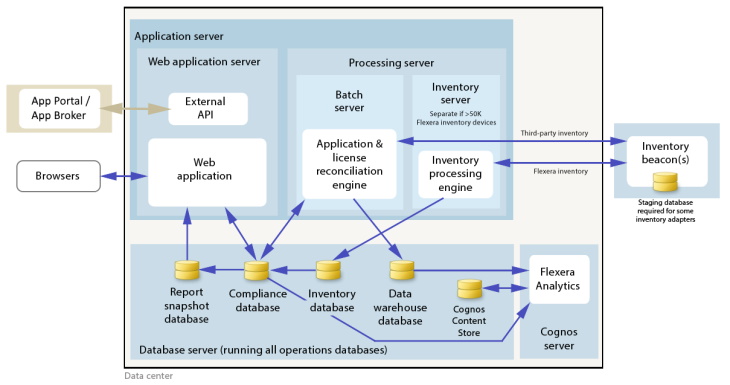Design the Topography
- At least one inventory beacon, and
typically more for a complex infrastructureTip: An inventory beacon may be installed on the same server as the batch server (defined shortly). This allows for greater functionality in future custom business adapters, as on this inventory beacon alone business adapters may operate in "connected mode".
- An inventory server, which can also be duplicated across multiple servers if you are gathering FlexNet inventory for many tens of thousands of devices (see below)
- One (and only one) batch server
(also known as a reconciliation server) that imports third-party
inventory, integrates FlexNet inventory, incorporates business-related
information, and reconciles everything to calculate your license
positionTip: Currently MSMQ limits the hostname of the batch server to 15 characters (excluding the domain qualifier).
- The database server (where the five underlying databases may also be split across separate database servers if required)
- The web application server that handles presentation of the interface
- A server for the business reporting
option (powered by Cognos), where applicable.
Tip: If the Cognos content store is installed on an SQL Server installation later than 2012, it should be run in SQL Server 2012 compatibility mode.
All system servers require a 64-bit operating system. The database server (alone) may have a 32-bit operating system, but a 64-bit operating system is recommended.
- Typically the first candidate for replication is the inventory beacon. This is often driven by network considerations as much as by simple scaling considerations.
- If your system manages more than 50,000 devices reporting FlexNet inventory alone (ignoring for the moment inventory through other third-party tools), the inventory server should be separated onto its own device. You can expect to duplicate a separate inventory server for (roughly) every 50,000 devices reporting FlexNet inventory.
- If you manage inventory from more than 100,000 devices, the batch server (or reconciliation server) may be separated from the web application server and installed separately.

- FlexNet inventory (from the FlexNet Inventory Agent) is uploaded to the inventory database by the inventory server, and then separately imported to the compliance database
- Third-party inventory imported from other tools is loaded by the batch server and stored directly in the compliance database
- Some time-based data is copied to the data warehouse database, and reports may combine trend data from here with current data from the compliance database
- Some data is copied to the snapshot database to improve presentation performance
- The web interface automatically displays a mixture of data from the snapshot database and the compliance database, as appropriate; and data manually input through the web interface is written back to the compliance database
- While Flexera Analytics can be installed on your application server, for performance
reasons Flexera Analytics is best installed on a separate server
(it has high memory use requirements).Note: All servers shown inside the data center should be within a single time zone. This is particularly important if you are using Flexera Analytics, since the Flexera Analytics Operational Dashboard combines time-based data from the database server(s) and the Cognos server.
Some of the inventory adapters (such as the Citrix XenApp server adapter, BMC Discovery, and HPUD adapter) require a separate staging database to allow for manipulation and normalization of data. This staging database may be installed on any convenient SQL Server, with one of the options being your central database server hosting your compliance database. Another option is to install the staging database on an appropriate inventory beacon. Decide on the location of this staging database as part of your design.
For more information about locating inventory beacons in your network, see Considerations for Inventory Beacons.
- The server type, either 'inventory beacon' or as named in the diagram above (for ease of reference in following instructions)
- The actual server name and IP addressTip: Keep in mind that an underscore character is not valid in a host name referenced by a DNS. If you have a host name that includes an underscore, you may need to set up a DNS alias for the server; or else use its IP address during the installation process.
- Which web server will be installed on each of these hosts.